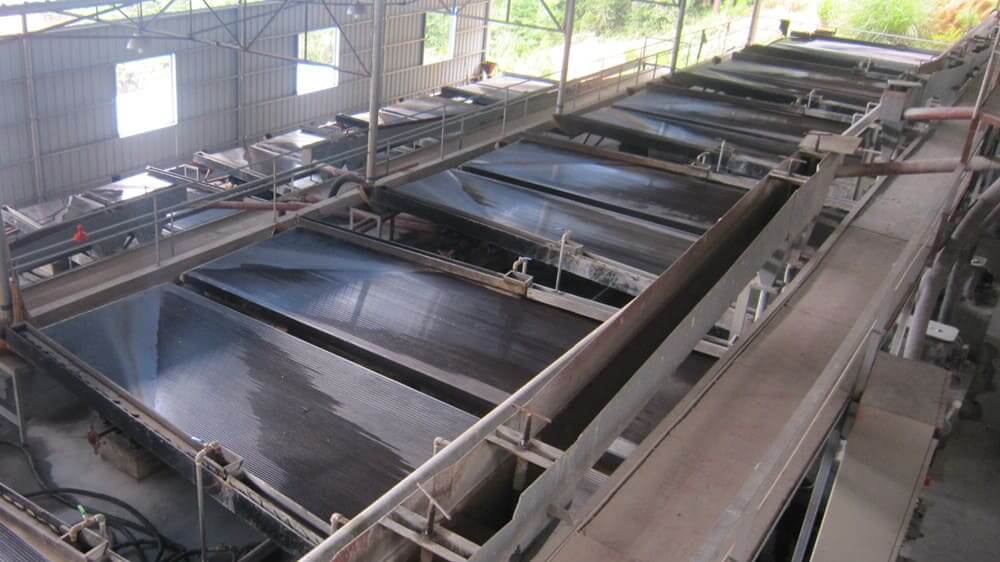A 6-S shaking Table, also known as a 6S shaker table, is a type of gravity separation equipment used in mineral processing and other industries to separate materials based on density and particle size. It uses a reciprocating motion to separate materials based on their density. It comprises a table surface with riffles or grooves and a shaking mechanism to generate vibrations. Following, we will discuss 9 FAQs about the 6-S shaking Table, including stroke & stroke times adjustment, the lateral slope of the bed surface and the amount of flushing water relationship, feeding concentration, feeding volume and processing capacity relationship, installation and debugging of shaking Table, etc.,
1. How to Adjust Stroke?
When the stroke adjustment handwheel rotates clockwise, the adjustment slider rises, and the stroke is reduced; when it is rotated counterclockwise, the adjustment slider falls, and the stroke increases. After the stroke adjustment is determined, tighten the fixing bolt at the lower part of the stroke handheel. When adjusting the stroke, the spring adjusting bolt at the rear of the gearbox must be adjusted accordingly. Otherwise, the parts will be damaged due to too loose or too tight parts.
2. How to Adjust Stroke Times?
Replace the motor pulley.
3. How to Match Stroke And Stroke?
Large strokes are matched with small strokes, and small strokes are matched with large strokes. When dealing with coarse-grained ore, the bed is thick and requires a larger stroke and a smaller number of strokes. The opposite is true for processing fines and slimes.
4. What is The Relationship Between The Lateral Slope of The Bed And The Amount of Flushing Water?
Increasing the lateral slope and the amount of flushing water can increase the lateral movement speed of the ore particles. However, increasing the amount of flushing water can also enhance the selective separation effect. Generally, the roughing or sweeping operation adopts “big slope and small water,” and the selection operation adopts “small slope and large water.”
5. What is The Relationship Between Feeding Concentration, Feeding Volume And Processing Capacity?
Feeding volume affects the flow rate of the pulp on the bed. Feed volume increases, concentrate recovery decreases, and tailings losses increase. When the concentration of ore feeding increases, the solid material layer thickens, the stratification speed decreases, the concentrate recovery rate decreases, and more metals enter the medium ore. Controlling the ore-feeding volume during production and appropriately increasing the ore-feeding concentration can improve the processing capacity. Still, the ore-feeding concentration, ore-feeding volume, and flushing water volume must be kept uniform. Otherwise, it will directly affect the distribution.
6. How to Install 6-S Shaking Table?
Install the fixed bracket according to the set longitudinal slope. Install the bed head and machine foot on the bracket (the slope adjustment handwheel is set in the feeding direction). The center point of the second machine foot and the three points of the center of the bedside linkage seat must be in a straight line. Correct the position where the four-bed support plate connectors of the second machine feet are engaged with the bed and fix the bolts. Pour an appropriate amount of lubricating oil into the connector. Position the support plates in the four connectors towards the concentrate. Place the bed surface smoothly on the machine foot support plate, and correct the contact position between the support plate and the bed surface base. Rotate the pulley of the transmission box by hand to make the reciprocating rod retract into the box to the endpoint, move the front of the bed so that the four support plates of the machine feet stand upright, connect the traction rod of the bed surface with the linkage seat of the bed head in a straight line, and tighten the bolts to fix it.
7. How to Measure Bed Slope?
Accurately measure the required height difference of the bed surface with the horizontal line at the two ends of the transparent plastic tube filled with clean water. That is, the required slope is obtained.
8. How to Set The Bed Surface’s Horizontal (slope) Height Difference?
After setting the predetermined height difference between the left and right sides of the bed, turn the slope adjustment handwheel on the machine foot for fine adjustment. If the handwheel rotates clockwise, the bed surface will rise in the direction of the ore feeding; if the handwheel rotates counterclockwise, the bed surface will rise in the tailings side direction. Fine adjustment of the longitudinal slope of the bed surface: Adjust it on the connection box of the machine foot support plate. First, loosen the machine foot channel steel bolts and then turn the screws on the side of the connection box to raise or lower the box body to adjust the longitudinal slope of the bed surface. After determining the slope, tighten the machine foot channel steel fixing bolts.
9. How to Debug Shaking Tables?
- Before starting, inject oil into the bottom plate of the bearing seat and lubricate all parts first.
- When starting, the pulley of the transmission box should run clockwise. If it is reversed, the power wiring should be adjusted.
- During installation and debugging, the spring of the transmission case should not be pressed too tightly. It should be loosened slightly to make a slight impact sound during operation. At this time, the bolts at the rear of the transmission case should be gradually tightened until the sound disappears so that it will not occur. The spring is too loose and too tight.
- Fine-tune the slope and adjust the ore-feeding concentration, ore-feeding volume, and flushing water volume according to the mineral movement conditions on the bed surface (the flushing water volume is appropriate when there is a thin water layer on the mineral surface on the bed surface).
LATEST PRODUCTS
Twin Screw Feeder
【Feeding Capacity】 10-160 t/h【Power】 2.2-…
Tubular Screw Conveyor
【Capacity】6-50 m3/h【Procesible Material】 …
Heavy Plate Feeder
Capacity: 100-240 m3/h Power: 15-45 kW Speed: 0…










